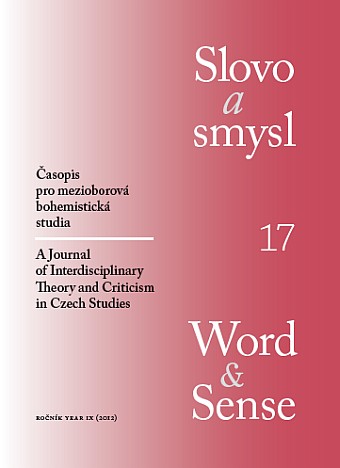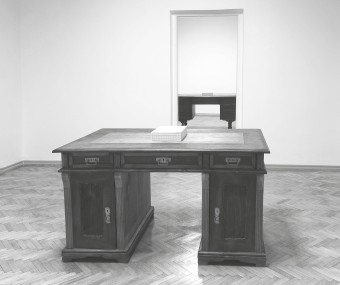Editorial
The topic of this issue – the relations of literature and visuality – as well as its title, The Eye of/in the Text, may seem to have already been thoroughly researched, if not simply banal. What is so striking about the realization that literature and visuality are intrinsically connected – that as we follow the written word, we become immersed in the author’s imagery, as well as the imagery created by our own minds? Nothing at all, in fact. So let us pose the question differently. What is the difference between the image and the text, and what do they have in common? Is visuality simply a matter of optics – a physiological phenomenon – or a quality of works of art? Is the visual aspect of literary texts limited to “written” images that we can see in the real world or in the imaginary space of art? Or does it go beyond that, to the possibility of creating, or making visible, something that is not primarily an image? To consider this question, it may be necessary to forget about the verbal realm of literature and concentrate instead on the graphical aspects of the text and the process of writing as a comparable gesture to the painter’s application of paint to the canvas – or, in short, to part with representation and embrace performance.
As early as the late sixties, Roland Bathes, who is now one of the most renowned visual studies theorists, rebuffed interdisciplinarity as “whipped cream on the academic cake.” According to Barthes, the goal of literary critics who wish to go beyond strict textual analysis should be not simply to replace one discipline with another, but to eliminate the barriers between them and their objects. Precisely this combination of the verbal, signifying aspect of writing and its visual, graphic performativity may be an approach that will transform interdisciplinary thinking about literature into co‑disciplinary thinking with literature. Such a research strategy will not settle merely for parallels and analogies between literary criticism and art history.
The title The Eye of/in the Text reflects the duality not only of contemporary visual‑literary approaches, but also, in particular, of the texts in this issue. On the one hand, we have vision directed into texture, a literary‑artistic eye, which examines the wide domain between both specific literary texts and (audio) visual works (the interpretation of various intertextual or intersemiotic parallels, topoi, motifs, and the influence of visual methods and means on a text and vice versa), and literary criticism and visual studies, as described, for instance, by J. W. T. Mitchell in connection with the cultural‑historical concept of “the Pictorial Turn”. Visual studies emphasizing the problematics of the gaze and spectatorship contribute immensely to this way of thinking about literature and writing, aptly illustrated, for instance, by Mieke Bal, Mary Ann Caws, and Kaja Silverman. These theorists describe some kind of “visual reading” of literature, in which linguistic signification and textuality are considered equal to what J.‑F. Lyotard calls “figural” processes, which frequently elude semiosis and representation. On the other hand, “the eye of the text” evokes both the problematics of seeing and visibility and the concept of the text as a living organism that is more than just the object of scrutiny: it is an observer that watches us and our reading. The eye of the text is thus a literary parallel to the self‑observing gaze that returns to itself from the depths of a canvas, as Leonardo da Vinci describes it in his Diaries. It is evident that it is precisely this reflected gaze that leads to the radical transformation of (self‑) perception.
The combination of potential readings of this title creates a literary‑visual figure, which is both the central point and at the same time the strategy of most of the texts in this issue, without necessarily being their main theme. Kaja Silverman’s study History, Figuration and Female Subjectivity in Tess of the d’Urbervilles, translated and introduced by Josef Fulka, serves as a kind of prologue to the entire issue. Silverman, one of the most outstanding pioneers of deconstructive and psychoanalytic criticism, analyses the visual strategy of Thomas Hardy’s novel and its “living images,” which she sees as phantasmatically structured on the basis of a close interrelations of desire and visuality. Through the sensitive interpretation of certain motifs of the novel, Silverman reveals the fundamental themes of the crisis of representation: the collapse of perspective, the ambiguity of seeing and not seeing, and the gaze that constructs its subject through colonization, limitation, configuration, and inscription.
We selected studies and sketches that work with specific texts and visual materials, but also with terms that enrich our thinking about literature. Thus, we discovered new visual readings of some Czech writers, as in Lucie Česálková’s Coctail – Nozzle – Blemish – Mercury. Notes on the Possibilities of a Visual Reading of Richard Weiner’s Prose Works, which suggests an approach to Weiner’s poetics as the verbal conception of imagery. Situating Weiner’s work in the wider context of modernity and considering his own artistic interests, she analyses how perceptive narrating subjects present the objects of their vision in the form of allusions to art history (Alma Tadema, Fra Angelica, Paolo Uccello, and Marc Chagall) or images mediated by modern optical inventions. Although Josef Hrdlička’s study Memory and Exile in The Diaries of Josefína Rykrová does not focus primarily on the link between the visual and the literary, he discusses the key theme of memory in relation to the classical ars memoriae, which is nothing less than visual memory, a technique based on images and imagery. The inspiration of film, not only on the level of motifs and composition, but also in the process of metapoetic reflection, is evident in the poetics of Milada Součková, in which words and consciousness are manifested as “the canvas of another’s memory.”
Another important subject of this issue is film, the moving image, and its affinity with literary texts or the general cultural code of writing. While Veronika Klusáková’s article “You Will Do Very Well If We File Down Them Horns”. The Tomboy and its Literary and Filmic Image McCullers’The Member of the Wedding shifts the sociocultural phenomenon of the “tomboy” out of the realm of feminist and post‑colonial theory to a conception of it as a subversive phenomenon consisting in performativity and masquerade that undercuts the traditional understanding of gender and racial roles. In his work “Into the Wild”: Image and Word in Terrence Malick’s Film The New World, Martin Škrabraha suggests two different ways of imitating reality, examining Malick’s cinematic stylization, which brings out the tension between the word, which is anthropocentric, and the photographic image, which is potentially cosmocentric.
Lukáš Prokops’ essay “I Have a Sense of My Own Inadequacy, You Know, Not Just My Own But Others’”: Henri Michaux and Zao Wou‑Ki treats the mutual concerns of Chinese painter Zao Wou‑Ki’s artistic project and Henri Michaux’s poetry, as well as his distinctive feat of “introducing graphics into words,” focusing on so‑called “Chinese sensibility.” Linking writing and visuality, Ondřej Váša’s study Where Are My Friends? Notes on Barthes’s Eiffel Tower interprets Barthes’s essay in the light of the historical conception of the “Parisian fetish” and “the symbol of a continuously reviving utopian future,” focusing on Barthes’s view of the Tower as neither a structure nor a specific image, which permits Barthes to step out onto the stage of his own fantasies. In his essay The Creative Destruction of Figures: Samuel Beckett and the Vision of the Unreadable, Tomáš Jirsa attempts a so‑called “physiognomy of writing,” which does not interpret the meaning of a work, but rather strives to reveal the creative movement of speech and how it intersects with various literary and art forms. With reference to Lyotard’s concept of Unreadable, Jirsa illustrates the intersections of Beckett’s writing, rising up “in despite of language,” and the gestuality of Arabic Islamic calligraphy.
In the section Critical Views, Michal Kosák discusses a book by Jiří Holý, Petr Málek, Michael Špirit and Filip Tomáš on the Holocaust in “Czech literature and cultural memory”. In additon, Václav Petrbok reviews the work of Tomáš Hlobil devoted to the beginnings of modern Czech aesthetics, and David Skalický introduces a recently published anthology of twentieth‑century Anglo‑American aesthetics. Within the subsection Czech Studies in the Czech Lands and Abroad, we present an interview with Michal Ježek by Professor Annalisa Cosentino from Udine.
In conclusion, I would like to thank the people without whom this issue would never have appeared. For offering the journal as a platform for this topic I thank the entire editorial board of Word and Sense, with special thanks to Jan Wiendl. I am also grateful to the UK Philosophy Faculty in Prague for a grant supporting the project as a whole. I thank Josef Fulka and Martin Mazanec for their enthusiasm and their devoted assistance in making the publication of these works possible. I would also like to thank Libuše Heczková for her valuable advice and her confidence in this project. And last but not least, I wholeheartedly thank Josef Vojvodík – for inspiring me and leading me into realms where the visual and the literary come together.


